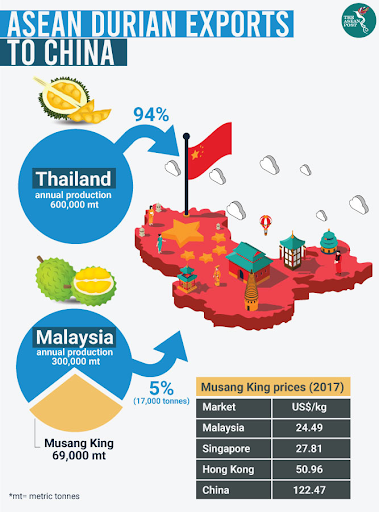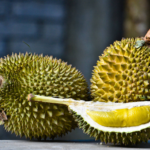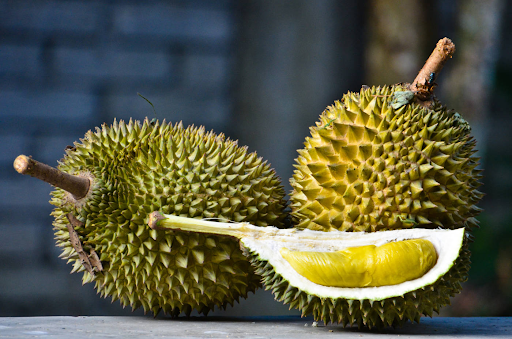(Note: This content is a 6-min read)
Malaysia is home to an abundance of fruits. From the sweet mangoes, rambutans, mangosteens to the unique scent of durians, Malaysia is known for its rich tropical fruits. When in season, the fruits of Malaysia are in such high demand that we find many cars stopping by at fruit sellers manning wooden stands and make-shift stalls along trunk roads and highways that run across the fruit gardens and kampung areas of the country.
One of the most celebrated fruits grown in Malaysia is Durian, also known as the King of Fruits, It is a distinctive fruit due to its strong odour and thorn-covered rind. There are over 100 varieties of Malaysian durians. The popular ones are D24, XO, Red Prawn, Golden Phoenix, Black Thorne and last but not least, the champion – Musang King! Generally, Malaysian Durians, not just the Musang King, are known to be the best in the world. This is due to vast heavy R&D and the creation of new durian breeds from cloning technology. Love them or hate them it can be said that the uniqueness of the fruit has attracted a lot of attention from the outside world. Over the past few years, consumers in western countries including the U.K., the U.S. and Germany have developed a taste for this exotic tropical fruit owing to cross-culture cuisine and food blogging. The increasing demand for this fruit has pushed the global market value of the durian fruit market to USD 20 billion in 2020 from USD 17.6 billion just 3 years prior. It is also forecasted that the market revenue in 2025 to reach USD 28.6 billion.
What makes Durian so popular?
Despite the pandemic, the demand for durians skyrocketed upwards. Not only did physical stores such as vendors and farm trucks experience an increase in their amount of orders, but online deliveries also grew as well. The Durian Raja Kunyit, better known as the Musang King, has been a constant favourite among Malaysians due to the sweetness and the rich texture it provides compared to other durian types. A study has shown that the Malaysian Musang King durian has one of the highest Brix* levels out of all durian varieties with a Brix level between 39 and 44. This just proves that there is a high amount of dissolved sugar when it is in a liquid solution in the Musang King durian, which could be part of the reason why this type is so popular.
*Brix is taken as a measure of sugar or sweetness of fruits
How profitable is the durian industry?
The cultivation of durian in Malaysia used to be a small-scale operation. The majority were characterized by “Dusun” or smallholdings of half or 1 hectare each. Usually, durians are also intercropped with other fruit trees. The local farmers did not see this fruit-growing as profitable compared to other commercialised crops like palm oil, cocoa, rubber, etc. However, soon, the interest in durian farming gained traction over time when the price of oil palm, cocoa, and rubber declined. In the past few years, durians have been highlighted as one of the chosen fruits grown in the Malaysian National Agro-food Policy (2011-2020). The durian has also been identified as a new source of agricultural wealth when the government announced plans to encourage farmers to invest in agro-tourism in May 2019.
The price of the famous Musang King durian increased steadily in the year 2017, reaching over RM100 per kilogram! The price rise has caused an increase of interest in durian cultivation by many folds. Since then, the durian has become the most popular crop planted in Malaysia, occupying 41% of the land cultivated, or approximately 70,000 hectares, achieving a total production volume in 1,000 metric tons of 210,870. These days, durians, especially Musang King, have been considered as a brand-new source of income for Malaysia. In 2016, durian production decreased slightly mainly due to the prolonged drought condition in the major growing areas such as Penang, Pahang and Kedah; however, the cultivated area and production increased back to nearly 73,000 hectares in the year 2018.
The Growth Potential of Malaysian Durian Industry

While there is significant growth for the durian market in Malaysia, there is still a lot of potential that can make it grow even faster in the future. As of today, Thailand controls 94% of the exports of durians around the world with Malaysia coming in second with only 5%. According to official data, durian is one of the fruits with the highest import volume in China, far higher than the popular cherries. While Thailand dominates the durian export market, it is undoubtedly Malaysia that is more well known for their speciality and quality of the King of Fruits. Therefore, there are a lot of areas that Malaysia can improve to reduce this gap and increase the supply. This includes technological advancements and digitalisation, which can boost productivity and harvest quality. Despite being one of the countries recognised for our lush green tropical climate, we have yet to fully utilise modern technology.
Looking at Japan, they are one of the leading countries that focuses on the advancement in technology for their agriculture sector. Despite having various growing concerns over agricultural sustainability, including forecasted water shortages by 2030, they plan to address this issue by developing a digital farming technology. By utilizing the Internet of Things (IoT) and Artificial Intelligence (AI) to collect and analyse data from their farming practices and the surrounding environment, this technology enables even inexperienced growers to improve agricultural productivity even in areas with limited access to water.
Apart from that, the commercialisation of many durian types is still lacking in our nation. Only the Musang King and D24 are known even among Malaysians. However, there are so many more different types of durian in Malaysia apart from those two. This comes after years of research from universities to create the perfect durian, which is making the skin less thick, the flesh thicker, the fruit sweeter and the seed smaller. The Department of Agriculture identified more than 200 durian varieties/clones in Malaysia since 1934 but today only 10 clones were recommended for mass production. Despite only commercialising a few of the clones, we are well known for the durians that we sold. Clearly, we can improve in this aspect and could one day be just like Japan that is famous for its high-quality Wagyu meat.
Ata-Plus’ upcoming issuer is a leading integrated plantation company that focuses on their durian plantation with a vision to build and bring in a new, modern urban system to revitalise and leapfrog the business to the next level. They will be using new technologies such as drones, IoT, AI and other robotics to ensure high productivity, reduce cost and ensure sustainability in their business. For more information, visit Ata Plus’s website at www.ata-plus.com. Stay tuned!
Author Profile

- I'm an analyst that is passionate about technology & innovation. Companies such as Google and Apple inspire me with new products that simplify our everyday lives.
Latest entries
 PerspectivesDecember 9, 2021Is Real Estate Still a Hot Investment Option?
PerspectivesDecember 9, 2021Is Real Estate Still a Hot Investment Option? AgricultureNovember 22, 2021Gaining “Durian Runtuh” Out of the King of Fruits
AgricultureNovember 22, 2021Gaining “Durian Runtuh” Out of the King of Fruits FoodOctober 8, 2021Healthy Bites, Healthy Life!
FoodOctober 8, 2021Healthy Bites, Healthy Life! CrowdfundingSeptember 27, 2021Infusing Technology to transcend the eyewear industry!
CrowdfundingSeptember 27, 2021Infusing Technology to transcend the eyewear industry!





No Comments